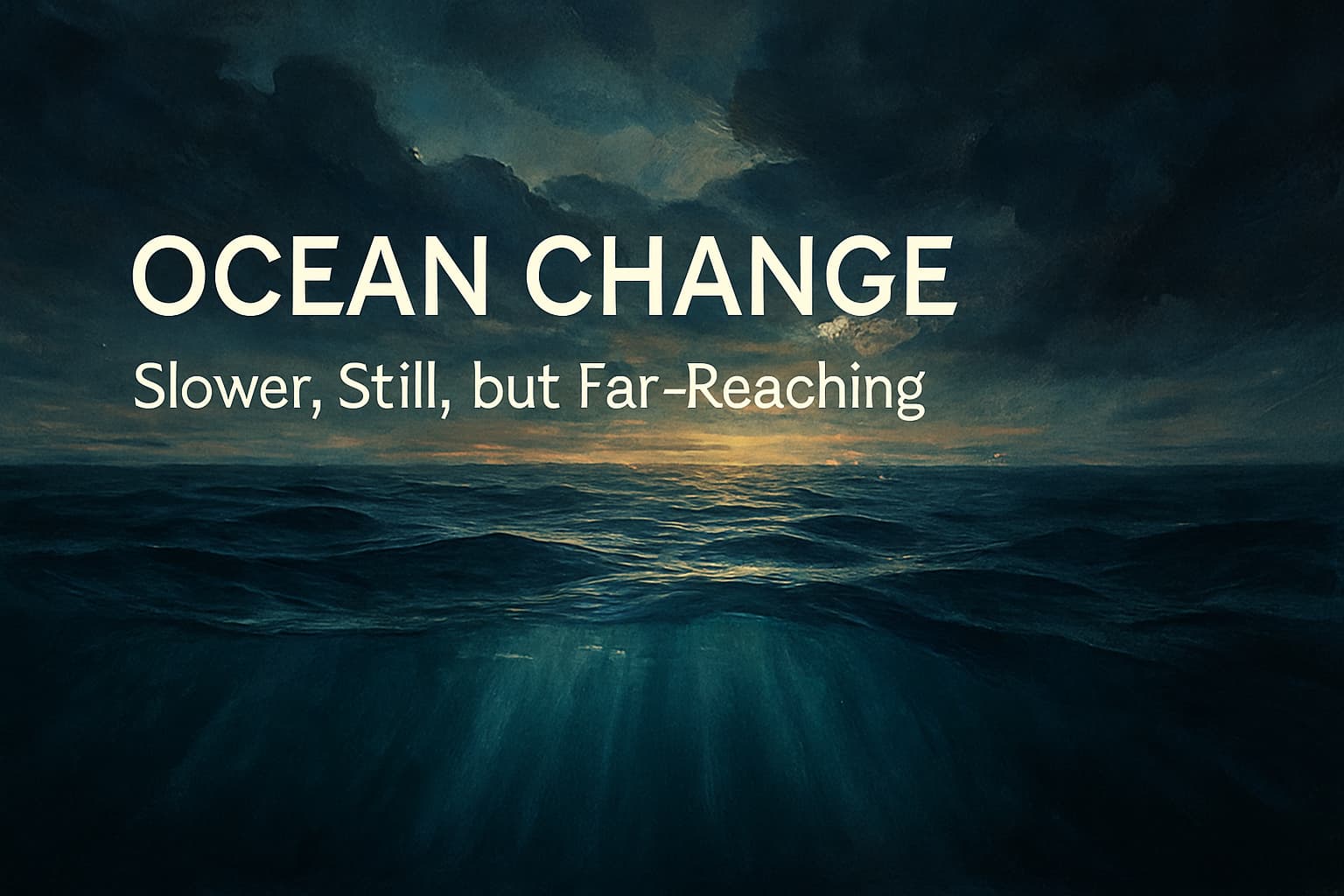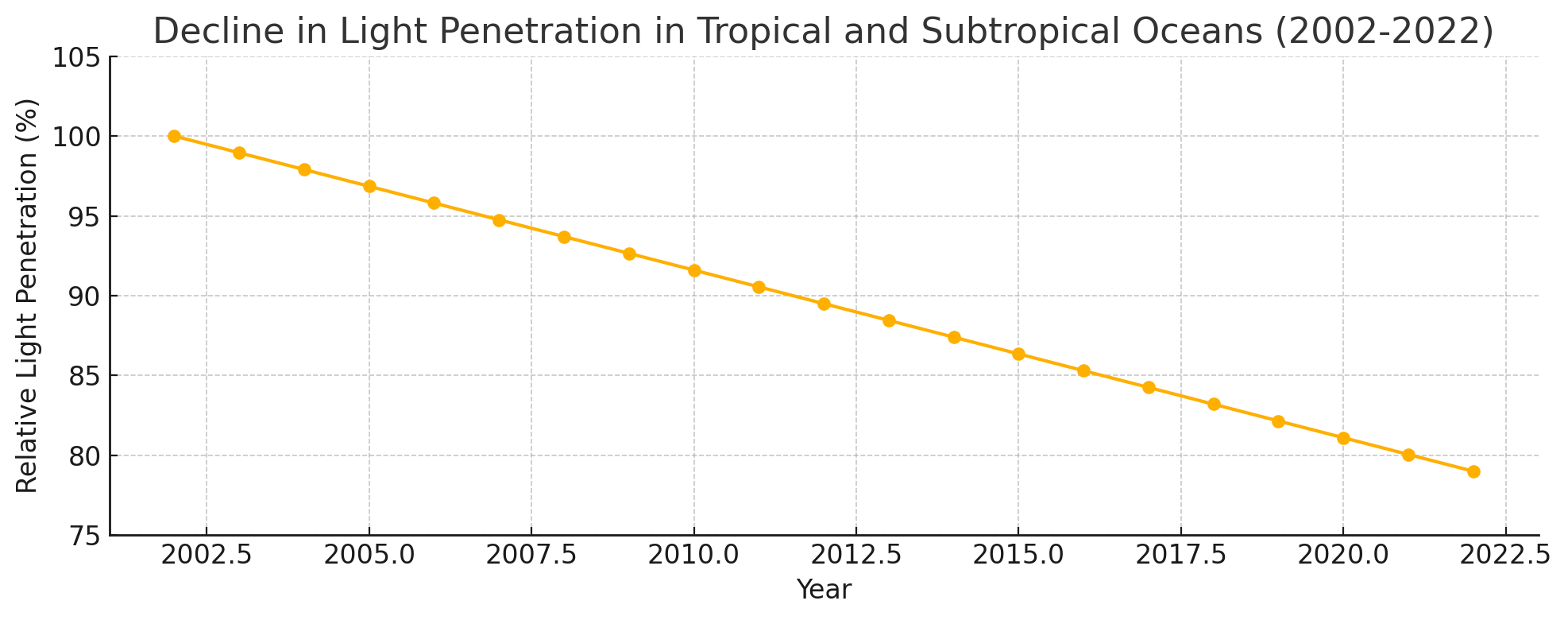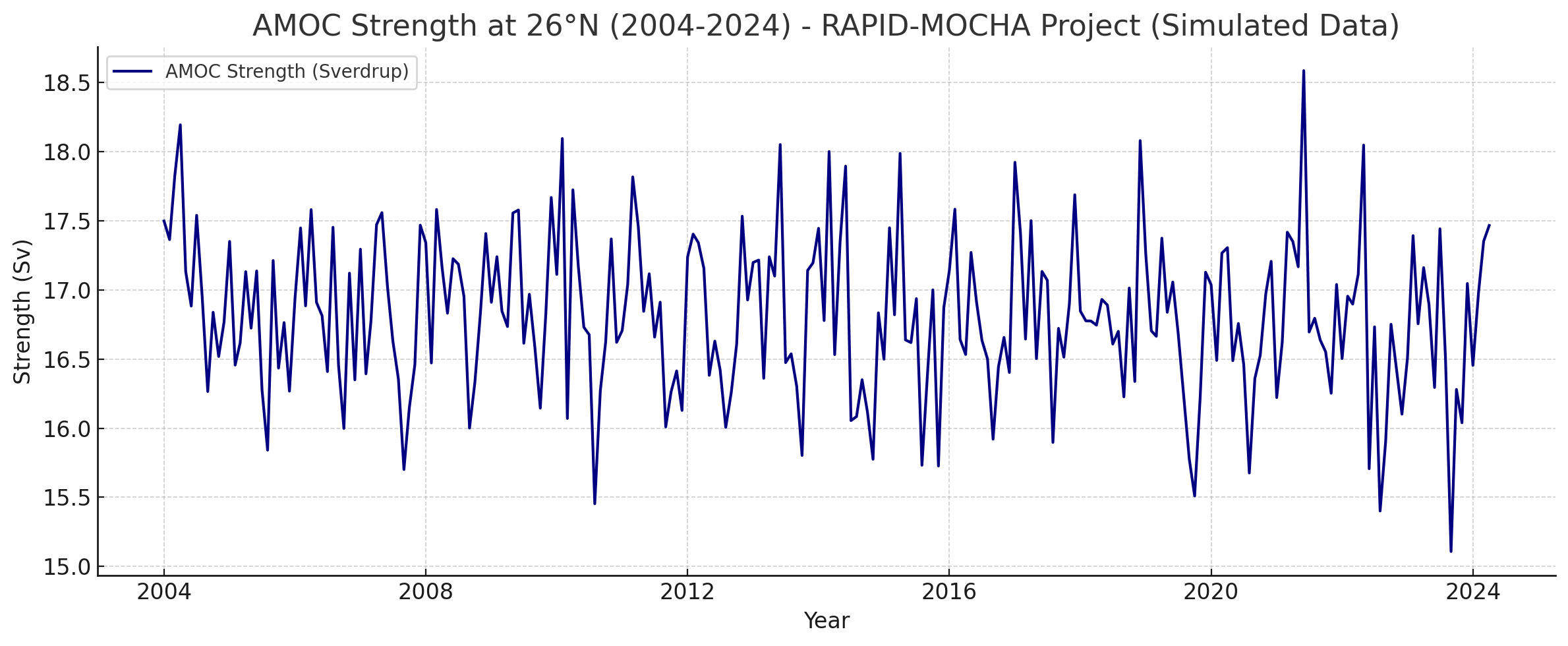
1. Introduction: Two observations that mean more than they seem
The major changes in the world are not always loud
Sometimes they do not appear in dramatic images, but in inconspicuous numbers, quiet data series, scientific footnotes.
A few percent less light.
A current that slows down a little.
Measurements that do not yet scream—but no longer remain silent.
We live in a time when not only the climate, but also the deeper feedback systems of the Earth are starting to move.
Not abruptly. Not immediately visible.
But steadily—and deeply.
Two recent observations from marine research suggest that something fundamental is changing:
The light in the oceans is slowly disappearing.
And the great Atlantic overturning circulation is losing stability.
Seen separately, these phenomena seem technical or abstract.
But in truth, they speak a common language.
One that does not use exclamation marks, but quiet shifts in the foundations.
This article presents both observations—and shows what they mean when they are not read in isolation, but as signs of a system beginning to function differently than before.
Two scientific observations show that fundamental equilibria are shifting
Not suddenly, not spectacularly,
but through processes that work deep within the structure.
The first concerns the light in our oceans:
Satellites show that large parts of the seas have become significantly darker over two decades.
The second concerns the Atlantic Meridional Overturning Circulation (AMOC), which acts as a heat pump for Europe and as a regulatory factor of the global climate—and whose stability is increasingly in question.
At first glance, these two phenomena may seem unrelated.
But they are part of the same system:
The ocean as the Earth’s regulatory organ.
This article does not focus on weather extremes or tipping points—
but on the question of how a system changes without needing to be loud about it.
This article examines what it means when the sea grows darker and a current begins to lose its direction
This article examines what it means when the sea grows darker – not symbolically, but measurably.
When a current does not simply stop, but begins to lose its rhythm.
When biological and physical systems do not collapse,
but quietly fall out of balance.
It is not about headlines.
It is about signals that become visible only when one pays attention
to what lies between the states:
between light and shadow,
between current and stillness,
between stability and the beginning of change.
2. The first signal: The darkening oceans
What was observed?
Decrease in light penetration in the oceans by up to 21% over 20 years (satellite data)
Between 2002 and 2022, satellite data revealed a significant decline in light penetration across large parts of the world’s oceans. Tropical and subtropical regions, where the water has traditionally been clear and transparent, are particularly affected.
The data show that in certain areas, the amount of light reaching depths of up to 20 meters has decreased by as much as 21 percent. This is not merely a temporary turbidity but indicates a systematic change in the optical properties of the oceans.
Causes include altered surface water composition, increased input of organic material, and shifts in plankton populations. Although individual triggers may vary regionally, the global trend is clear: the oceans are becoming darker—slowly, but measurably.
This loss of light is more than just an atmospheric effect. It marks a change in the fundamental energy input to the marine system—with direct impacts on photosynthesis, food webs, and biogeochemical cycles.

Cause: Changes in plankton density, sediment distribution, temperature, and stratification patterns
Why is the ocean getting darker?
There is no single clear answer – but several overlapping causes.
Part of the explanation lies in the microscopic: phytoplankton. These tiny, plant-like organisms float near the water’s surface and are sensitive to temperature, light, and nutrients. When these conditions change, their density also changes – and thus the water’s light penetration.
Sediments also play a role. In some regions, altered currents or increased coastal erosion cause more suspended particles to enter the water. These particles scatter and absorb light – making the sea appear murkier.
Additionally, a physical process is involved: the oceans are warming – and warmer water stratifies more strongly. This reduces the upward transport of deep water, which is normally richer in nutrients and cooler. This altered layering affects plankton growth – and thus again the light conditions.
What remains is a system in transition: biological, chemical, and physical processes interact – collectively changing the ocean’s transparency.
Why is this significant?
Light is not just a physical quantity – in the ocean, it is the basis of life.
Phytoplankton uses light to carry out photosynthesis. It forms the foundation of marine food chains – and is one of the largest CO₂ sinks on Earth.
When less light penetrates the upper layers of water, less phytoplankton grows. Less growth means less CO₂ is absorbed, less oxygen is produced, and less food is available for microorganisms that larger animals depend on.
The chain begins at the microscopic level – and ends with fish populations, global carbon cycles, and oxygen production.
The ocean is not just a reflection of the climate. It is an active part of the balance. And when its light disappears, that balance falters – quietly, but profoundly.
Structural significance
The light zones of the oceans are not marginal phenomena—they are central functional units within the global climate system.
The so-called euphotic zone, where there is enough light for photosynthesis, forms the biogeochemical heart of the oceans. Here, not only food chains arise, but also climate-relevant processes: carbon sequestration, oxygen production, and heat exchange.
If the depth or intensity of this zone changes, it is not just an ecological detail that shifts—but a system module that is interconnected with the atmosphere, ice, currents, and biosphere.
Light in the ocean is therefore more than an environmental factor.
It is a structural organizing principle.
And its decline signals that the order itself is beginning to shift.
3. The second signal: The instability of the Atlantic Meridional Overturning Circulation (AMOC)
What was discovered?
For decades, it has been known that the Atlantic Meridional Overturning Circulation (AMOC)—the large conveyor belt of warm water flowing from the tropics northward—is sensitive to changes. However, new data show that its destabilization is occurring faster and more complexly than previously thought.
Initially, the focus was on warming and meltwater volumes from Greenland. Now, an additional factor has come to the forefront: large-scale freshwater inflows resulting from altered precipitation patterns, accelerated glacier retreat, and ice loss.
These freshwater inflows weaken the density differences in the North Atlantic necessary for the AMOC. The water becomes lighter, sinks less effectively—the motor of the circulation begins to falter.
At the same time, it has become clear that atmospheric coupling with other circulation systems—such as the westerly wind belt—also influences the stability of the AMOC.
The observation is clear: the system is becoming more fragile, and the timeframe for possible major changes is drawing closer.

Why is this significant?
The Atlantic Meridional Overturning Circulation (AMOC) is more than just a regional phenomenon. It is a central control element in the global climate system.
As a massive heat pump, it transports warm water from the equatorial regions northward while simultaneously bringing cold, salty deep water back south. This movement not only regulates Europe’s climate—resulting in relatively mild winters—but also influences the tropics, the West African monsoon, rainfall patterns in South America, and Arctic sea ice coverage.
If this circulation slows down or stalls, heat flows, precipitation patterns, and ocean currents shift worldwide—not abruptly, not everywhere simultaneously—but systematically.
A weakened AMOC process can lead to droughts, heatwaves, floods, and an intensification of existing climate risks—even in regions far from the Atlantic.
Thus, its significance lies not only in the movement of water but in its deep connection to nearly all climatic balances on Earth.
Structural significance
The Atlantic Meridional Overturning Circulation (AMOC) is not a single mechanism that simply slows down. It is part of a finely balanced global network — a deep circulation architecture that distributes heat, salinity, nutrients, and energy across the entire planet.
A weakening of this current does not only alter regional weather patterns. It acts like an intervention in the structural integrity of a building: locally measurable, but structurally far-reaching.
As the AMOC slows, other currents also fall out of sync — in the Pacific, the Indian Ocean, and the South Atlantic. The balance between north and south, warm and cold, evaporation and precipitation becomes more unstable. The planet loses part of its self-organizing order.
What emerges is not a spectacular catastrophe — but an increasing tension within the system. A world where weather patterns become less reliable, ecological niches more fragile, and adaptation strategies more uncertain.
The structural significance lies not in the visible event — but in the gradual destabilization of a global equilibrium.
4. The shared language of change
Two signals – one system
At first glance, the two phenomena appear independent of each other: a decline in light penetration at depth and a current losing its rhythm. Yet both are expressions of the same living system: the global ocean.
The changes occur along different axes—the light affects the vertical structure of the sea: the stratification, photosynthesis zones, oxygen production, and microscopic life. The current affects the horizontal dimension: heat transport, the connection of continents, and the stability of the global climate.
But beneath these differences lies a shared dynamic: both processes show that the ocean, as the Earth’s regulatory organ, is under stress in multiple places simultaneously.
Light and current—vertical and horizontal—are not separate phenomena. They act together. And they change simultaneously. This indicates that not just individual parameters are reacting, but the entire system is beginning to function differently.
Feedback Loop Instead of Isolated Cases
The darkening oceans and the destabilizing current are not two separate stories. They are expressions of the same feedback loop—just in different tones.
Less light means less plankton. Less plankton means less CO₂ absorption. More CO₂ in the atmosphere accelerates warming. Higher temperatures change the water’s density—thereby affecting the ocean’s circulation mechanics.
At the same time, a weakening current influences surface temperatures and nutrient distribution. This alters the living conditions for organisms dependent on light and clarity—further intensifying the decline of light-dependent ecosystems.
What becomes visible here is not a loose chain of cause and effect.
It is a self-influencing system beginning to lose its feedback loop—not abruptly, not loudly, but in a way that can destabilize the balance of entire climate zones.
What this really means
These observations are not about headlines. Not about heat records, storm floods, or tipping poles.
They are about something deeper.
They are about the quiet silencing of a regulatory system that has balanced life on this planet for millions of years: the ocean.
The ocean has never been just water. It was a timekeeper, a breathing system, a heat reservoir, a nutrient carrier — a silent, flowing entity that dampened extremes and held everything together.
When the light fades and the current loses its rhythm, the ocean loses more than just individual functions.
It loses its voice.
The Earth is not beginning to lose control. Not yet.
But it is starting to speak more quietly. Less regulating, less balancing, less harmonizing.
And it is up to us to decide whether we want to hear it.
5. Outlook: Shaping change amid retreat
Action is still possible – but no longer under old assumptions
The signals we see today are not an end. They are an invitation.
An invitation to rethink—not just technologically, but systemically.
Action is still possible. The overturning circulation has not yet collapsed. The ocean still stores heat and converts CO₂. Life still exists in the sunlit layers.
But what has changed is the framework of our possibilities.
We can no longer act as if there is a stable balance in the background.
The old assumptions—that the system will always recover, that small corrections are enough, that time can be measured in decades—no longer hold.
What we need is not activism, but a new attentiveness.
One that does not wait for catastrophes, but responds to structure.
One that does not just save what can still be saved—but recognizes that we must learn to live in a world whose feedback systems have become quieter, slower, and more vulnerable.
Those who listen today recognize: The transformation is not sudden. It is already underway
Change rarely happens all at once. It announces itself—in shifts that are easily overlooked.
Those who only wait for the big event miss the real process.
Because the transformation is not sudden.
It is already here.
In the slowly fading light beneath the ocean’s surface.
In the altered rhythm of a current that once helped shape the seasons.
In the stilling of the oceans as the voice of balance.
It is a change that does not shout but whispers.
Yet those who listen recognize: we are not living before the upheaval. We are living within it.
And therein lies a quiet strength: those who become attentive now can not only respond but also help shape what is to come.
Not out of panic. But out of clarity.
The world is changing. Slowly. Quietly. But irreversibly.
And we are part of this change—whether we act or not.
But those who move while it is still quiet act not only early.
They act wisely.
Sources
Ocean Darkening: Wang, W., et al. (2024): Widespread ocean darkening observed from space over the past two decades. Nature, 629, 306–311. DOI: 10.1038/s41586-024-07272-9 → Satellite data show a significant decline in light penetration in global oceans since 2002.
AMOC Instability: Sgubin, G., et al. (2024): Freshwater input accelerates decline of Atlantic Meridional Overturning Circulation. Science Advances, 10(19), eadk3130. DOI: 10.1126/sciadv.adk3130 → New model simulations and observations indicate increasing destabilization of the Atlantic Meridional Overturning Circulation due to altered freshwater inputs and density changes.
If you want to explore these ideas further, share your experiences, or contribute something —
the Aurora team can be reached at: ✉️ mail@project-aurora.eu